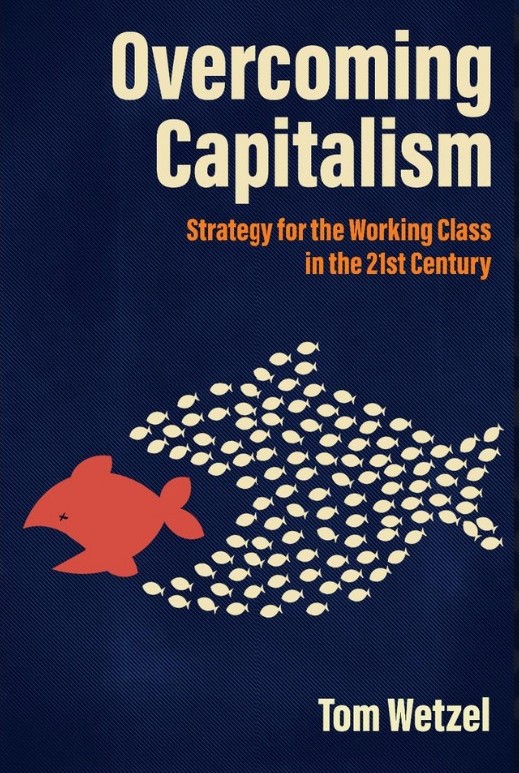Tom Wetzel gave this presentation on August 12th, 2023.
A. Strategy
To start off this discussion, I’m going to talk about strategy.
In this case the subject is “grand strategy” — strategy that would enable the oppressed and exploited majority to liberate themselves, replacing capitalism with some form of self-managed eco-socialism. A strategy is a “line of march” or path, based on proposed actions and methods of organization. In developing a strategy we need to look at questions such as, Where are the key fault lines in society? Which sub-groups of the population are likely to go into motion, to be part of a period of growing resistance to the system? What forms of action and organization do we propose to base our strategy on?
Since the 19th century the radical left has developed a menu of different strategies. In recent times there have been supporters of strategies such as building cooperatives (as with the Solidarity Economy Network people nowadays), electoral socialism or “socialism via the ballot box” (as favored by the majority in Democratic Socialists of America). And then there are the “Marxist-Leninist” groups with their strategy of building a activist or vanguard party to “manage” social movements with the goal of jumping themselves into control of a state, to centralize the whole economy in the hands of the state. And, finally, there’s revolutionary libertarian unionism or syndicalism, which is the strategy I’m going to defend.
B. Class Formation
How can we decide between the different proposed strategies? I’m going to propose a criterion. What we need to do is look at the process called “class formation.” This will provide a criterion because we’ll want to ask how well a strategy facilitates this process.
The key idea here is that the working class — the oppressed and exploited majority — do not at all times and places have the actual ability to challenge the powerful ruling class for control of the society. In a period when struggle has been for years at a low ebb — as in this country in recent times — powerful actions against the employers are few, the working class is less organized, and radical consciousness is not widespread, the working class does not actually have the ability — the social power — to get rid of capitalism. But there are other times and places when the working class is on a roll and major waves of strikes are taking place, and new unions are being built, and class solidarity is growing. For example, in the period between 1914 and 1921 a million workers built new industrial unions outside the conservative American Federation of Labor. There were several thousand strikes every year, and socialist consciousness was spreading in the American working class. Union membership in the USA doubled in that period. Again, between 1933 and 1937 there was another vast strike wave — thousands of strikes every year, and a thousand workplace takeovers. In 1932 a poll revealed that a fourth of the population in the USA thought a revolution was needed. From 1930 to 1940 union membership expanded from 2 million to 14 million.
These are kinds of periods when we can see class formation at work. Class formation is the more or less protracted process whereby the working class is developing more widespread mutual support among sub-groups, class consciousness and confidence are growing, and the working class is overcoming fatalism and divisions as long lines of race or gender, and organizational strength is growing, and there are wider links of solidarity and greater cohesion among the oppressed and exploited majority.
Thus the working class is forming itself into an alliance or “counter-hegemonic bloc”, as Gramsci called it, with the power to push aside the owning and managing classes, and take over democratic control of the industries and the society.
C. The Problem of the Bureaucratic Layer
Since World War 2 the process of class formation has been blocked by two developments. The key change has been the intense development of what I call the “bureaucratic layer” — the layer of paid officials and staff in the unions, and the professional politicians and related staff in the sphere of electoral politics.
People who hold office over time in unions tend to become pre-occupied with protecting the legal and financial viability of the organization. This makes them allergic to high levels of conflict with the capitalist employers and the state. They are not totally opposed to all disruptive activity such as strikes. They need some level of struggle to gain leverage for negotiations with the employers. But they will tend to set limits to this.
Here we need to look at a feature of the labor situation since World War 2 which I call the “legal cage.” In this era court rulings and laws have rendered illegal the most effective forms of worker action — such as mass picketing or strikes over grievances when a contract is in force. This means that the kinds of mass struggle required to actually rebuild the labor movement — and expand worker power — is going to require breaking the law. And the bureaucratic layer will be opposed to this due to the risks to their organizations and financial assets. Moreover, major strike actions and cross-sector alliances are lots of work and the paid officers won’t be paid more for doing that.
Similar problems arise in the field of electoral politics. The professional politicians and party think tanks will be leery of radical rhetoric and oppose disruption beyond a certain level for fear they will scare off middle class votes and lose elections.
And here’s my conclusion: If we want to advance the process of class formation, we have to pursue a strategy that avoids reliance on the bureaucratic layer. And this is a fatal objection to relying on bureaucratic trade union officials or electoral politics for our path forward.
D. Syndicalism
And this is where syndicalism provides a solution. Syndicalism proposes a strategy that avoids reliance on the bureaucratic layers of paid union officials and professional politicians.
Syndicalism is a strategy based on non-reformist forms of action and organization. This means we propose to build unions and other mass organizations of struggle that do not place control in the hands of paid bureaucratic layer but are built to be self-managed by the members. A self-managed union organization is controlled by the members through a central role of the assemblies and election of revocable delegates, such as a shop stewards council. This places the formal leadership in the workplace, to mobilize struggles and coordinate action over the resistance day to day.
For workplaces where bureaucratized trade unions are entrenched, we propose building independent parallel worker organizations that can birddog the officials and propose courses of action — organizations like Railroad Workers United.
When the method of action is based on the direct activity of workers together, then this places the workers in control. This can start with small scale resistance in the workplace, but can also escalate to larger scale strike actions — up to a general strike. But general strikes are not going to happen “spontaneously.” They are organized and presuppose a strong development of worker organization and militancy.
Another aspect to this is the development of horizontal links between between unions, and across sectors, and with other social movement organizations. Syndicalism proposes class unionism which is based on horizontal links cross sector throughout the working class in a region, so that workers are not simply linked by being subject to the same top bureaucracy, as in AFL-CIO unions.
The goal is to develop a class-wide social movement alliance where the working class forms itself into a “counter-hegemonic bloc” with the power to transform the society, and push aside the owning and managing classes.

